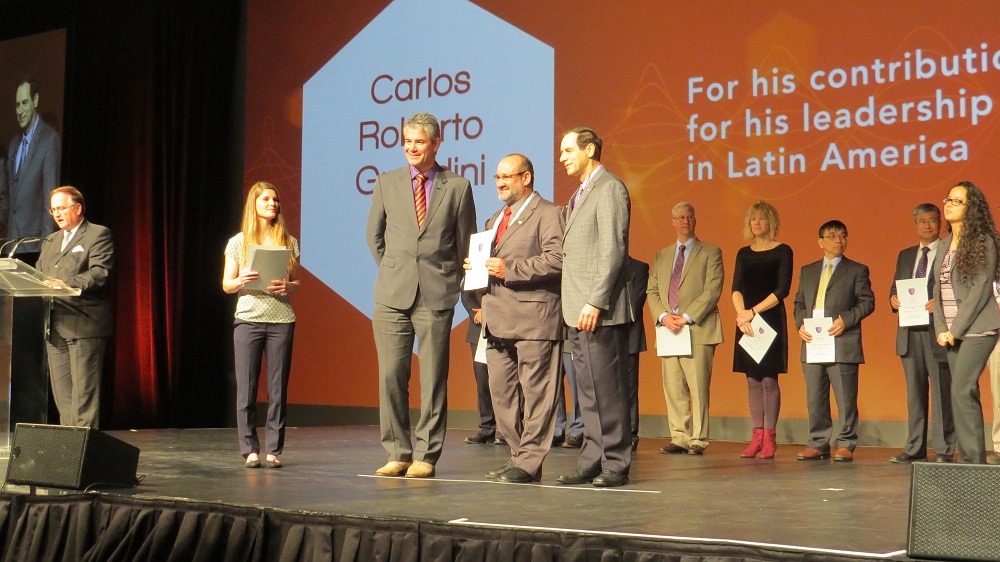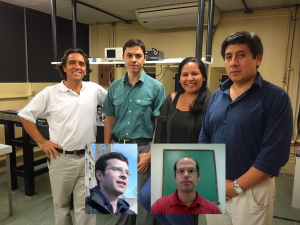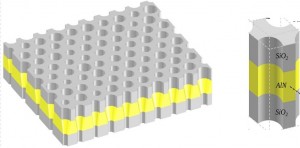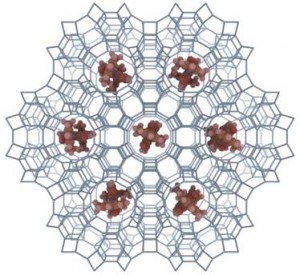|
||||||||||||||||||||||||||||||||||
To unsubscribe, click here
|
||||||||||||||||||||||||||||||||||
Sidney José Lima Ribeiro was born in Sao Paulo (Brazil) in 1959. In high school he signed up for a technical course in Chemistry in the seaside city of Santos. He later moved to Araraquara also in the state of São Paulo where he graduated with a bachelor`s (1982), master`s (1987) and then a doctorate degree (1992) in Chemistry at the University of the State of São Paulo Júlio de Mesquita Filho (UNESP). He began his teaching career in the Chemistry Institute – UNESP in 1986. From 2001 to 2003 he was the head of the General and Inorganic Chemistry Department. In 2008, he became a full professor. His postdoctoral fellowship was in France, at the École Centrale Paris (1994) and at the Centre National d’ Etudes des Telecomunications, CNET (1995).
Professor Sidney Ribeiro is a member of the editorial board of the Journal of Sol-Gel Science and Technology (Springer) and the Journal of Non-Crystalline Solids (Elsevier) and editor of the Eclectic Chemistry journal (Chemistry Institute of UNESP).
He is the author of over 300 peer reviewed articles published in international journals, 7 books or book chapters and 19 patent applications. His scientific production has approximately 5,000 citations. He has mentored or supervised a hundred research works, including doctoral theses, master`s dissertations, postdoctoral research and scientific initiation projects.
He was a visiting researcher at the National Institute for Research in Inorganic Materials (Japan) and visiting professor at the University of Trento (Italy), at the Universities of Angers and Toulouse (France), the University of Aveiro (Portugal) and the Federal University of Juiz de Fora (Brazil).
He has been a member of the São Paulo State Academy of Sciences since 2012 and full member of the Brazilian Academy of Sciences (ABC) since 2015.
Here is a brief interview with the researcher.
SBPMat newsletter: – Tell us what led you to become a scientist and work in the Materials area.
Sidney Ribeiro: – I am a chemist. I studied a technical Chemistry course at the Carmelite High School in Santos. Afterward, by now truly enjoying chemistry, I got my Bachelor`s Degree in Chemistry here in Araraquara. I graduated in 1982. I completed my Master`s in Spectroscopy of Lanthanide here at UNESP under the guidance of Professor Ana Maria G. Massabni which included a national doctoral “sandwich” program, with a part of the work done here in Araraquara and another part at the Federal University of Pernambuco under the guidance of Prof. Gilberto Sá. In my doctoral research I started to work in the interface between Chemistry – Physics – Materials Science, in which we participate until today. My post-doctoral research was at the École Centrale Paris and CNET France Telecom from 1994-95.
SBPMat newsletter: – In your opinion, what are your main contributions to the Materials area, considering all aspects of scientific activity?
Sidney Ribeiro: – We have worked with materials containing rare earth ions with applications in photonics and biomedicine. We have two very well-cited review papers that can serve as an example for those interested in learning more about our work:
1-Carlos, LD et al, Lanthanide-Containing light-emitting organic-inorganic hybrids: a bet on the future, Advanced Materials (2009) 21(5) 509-534.
2-Correia SFH et al, Luminescent solar concentrators: challenges for lanthanide-based organic-inorganic hybrid materials, J. of Materials Chemistry A (2014) 2 (16) 5580-5596.
Our postgraduate program is classified by Capes as level 7 (the highest) and our undergraduate courses are among the best in Latin America. This basic science work has resulted in the training of skilled labor (27 master’s degrees, 20 doctoral degrees and 23 postdoctoral supervisions and dozens of undergraduate students), the deposit of 19 patent applications, and spin-offs or cooperation with a dozen small businesses that now manufacture products developed in our laboratories. The trinomial research-education-extension is definitely well explored at IQ-UNESP.
SBPMat newsletter: – Please leave a message to the readers who are beginning their scientific careers.
Sidney Ribeiro: – We are all born liking science. Who, as a child, in a moment of scientific inspiration, didn’t mix our mother’s perfume with insecticide and some olive oil just to “see what came out of it”? This taste for science has to be preserved in our educational system. And for those who are starting out I say: go ahead. The country needs you. Someone said that when you do what you love you will never “have to work”. Work becomes your pastime and it’s really awesome.
Brazilian researchers were awarded the status of “Fellow, Biomaterials Science and Engineering” (FBSE) by the International Union of Biomaterials Science (World’s Biomaterials Societies). The honorary title is a recognition of excellence in professional performance and the achievements made in the field of Biomaterials Science and Engineering. The new fellows now are part of an international college, joining 300 researchers who are committed to strengthening and divulging the field of Biomaterials. The honor was awarded in a ceremony at the opening of the 10th World Biomaterials Congress, held in Montréal (Canada) in May.
One of the new FBSE of Brazil is Professor Carlos Roberto Grandini (from the State University of São Paulo, UNESP, campus Bauru), counselor of SBPMat and 1st Vice President of the Latin American Society of Biomaterials and Artificial Organs (SLABO). Grandini received the honorary title for his contributions in the field of metallic biomaterials and for his leadership in the Latin American scientific community. Besides Grandini, the other new fellows are the Brazilian researchers Aron Jose Pazin de Andrade (Instituto Dante Pazzanese de Cardiologia), Luís Alberto Loureiro dos Santos (Federal University of Rio Grande do Sul, UFRGS) and Marivalda de Magalhaes Pereira (Federal University of Minas Gerais, UFMG).

 It is with deep regret that SBPMat announces the passing of Prof. José Arana Varela of the Chemistry Institute of Unesp, Araraquara, on 05/17/2016. Professor Varela was one of the founders of SBPMat, and its president from 2010 to 2011.
It is with deep regret that SBPMat announces the passing of Prof. José Arana Varela of the Chemistry Institute of Unesp, Araraquara, on 05/17/2016. Professor Varela was one of the founders of SBPMat, and its president from 2010 to 2011.
SBPMat sympathizes with the family of Professor Varela, in a sad day when Brazilian science loses one its exponents.
The Board of SBPMat
Related links:
[Paper: Oxide-cladding aluminum nitride photonic crystal slab: Design and investigation of material dispersion and fabrication induced disorder. Melo, EG; Carvalho, DO; Ferlauto, AS; Alvarado, MA; Carreno, MNP; Alayo, MI. Journal of Applied Physics 119, 023107 (2016). DOI: 10.1063/1.4939773.]
Designing structures to manipulate light
Photonic crystals are nanostructures capable of manipulating visible light and other forms of electromagnetic radiation by organizing its structure in periodic patterns.
In addition to the natural materials with these characteristics, such as opal, photonic crystals are man-made and are generally classified as metamaterials. Its characteristics (shape, size and composition) are designed to control light waves. Through nanofabrication processes these become tangible structures and are used in many “nanophotonic” devices. Nevertheless, producing these structures is by no means a simple task.

With a study based on computer simulations, a team of Brazilian scientists headed by researchers from the Polytechnic School of the University of São Paulo (EPUSP) presented scientific contributions that can be used to improve the production of photonic crystals to enhance their performance of manipulating light. According to Emerson Melo, the first author of a paper on the study that was recently published in the prestigious Journal of Applied Physics (JAP) “the work presents a detailed analysis of the effects caused by nanofabrication processes on the optical properties of planar photonic crystals produced on silicon dioxide-cladding aluminum nitride”.
“The idea emerged from the opportunity of combining the excellent optical and physical characteristics of aluminum nitride (AlN), such as transparency over a wide wavelength range (from the near infrared to the ultraviolet range), its non-linear effects, great stability and temperature variations, with the advantages provided by photonic crystals, such as the construction of high-efficiency waveguides, curves and resonant cavities in nanoscale dimensions, in addition to the various optical effects of photonic crystals, such as very low group velocity and low-intensity nonlinear effects of the materials”, adds Emerson, who is a doctoral student in Microelectronics – Photonics in EPUSP, within the Group of New materials and Devices of the Microelectronics Laboratory of the Department of Electronic Systems Engineering. Emerson`s doctoral research, whose advisor is Professor Marco Isaías Alayo Chávez, enquires into the study, production and characterization of nanophotonic devices such as waveguides, resonant cavities, optical modulators and switches in aluminum nitride photonic crystals.
The study that resulted in the paper published in the JAP began with an experimental stage. Thin films of aluminum nitride and silicon dioxide (SiO2) were manufactured by the EPUSP group, and with the research collaboration from UFMG and UNESP they were analyzed by the Variable Angle Spectroscopic Ellipsometry (VASE) technique to determine the dielectric functions, which was later used as the theoretical research data.

Then, the EPUSP group designed a photonic crystal, ideal in terms of performance and manufacturing possibilities, consisting of a layer of aluminum nitride between two silicon dioxide layers, with round holes arranged in a repeating pattern along the “sandwich” material. Using analytical and numerical methods, the USP researchers simulated some of the “side effects” of the photonic crystal manufacturing processes of this type (e.g., variations of size and location of holes) and theoretically analyzed how these imperfections affect the performance of the photonic crystal.
The theoretical research of Emerson and the other researchers of EPUSP focused on the imperfections generated in the two main stages of the nanofabrication process normally used in photonic crystals such as the one studied: electron-beam lithography and plasma-assisted dry etching. “The results presented allow to assess that the electron-beam lithography process has greater effect on the performance of devices that explore the dispersion of electromagnetic radiation through the photonic crystal, such as prisms, optical switches and modulators”, says Emerson. “However, the quality of the dry etching process has a more profound impact on the characteristics of devices into which linear or exact defects are introduced in the periodic network of the photonic crystal to insert harmonic modes within the photonic band gap. In this case, the dry etching has to be extremely well controlled for manufacturing the devices where waveguides and resonant cavities are among its main elements”.
In addition to making headway in understanding the role of nanofabrication processes of photonic crystals in the performance of nanophotonic devices, the authors of the paper were able to define a method to design planar photonic crystals with core and cover in thin film dielectric materials. “The methodology includes determining the dielectric function of the material by the spectroscopic ellipsometry technique to analyze the dispersion effects of the materials, determining the geometrical parameters that maximize the photonic band gap and the analysis of the impacts caused by deviations introduced in the manufacturing process”, explains Emerson.
The research received financial support from the National Council for Scientific and Technological Development (CNPq) and from the Financier of Studies and Projects (Finep).
The authors of the article. From left to right, at the laboratory:.
The Laboratory of Nanostructured Films and Spectroscopy at São Paulo State University (UNESP), campus in Presidente Prudente, SP, Brazil, invites applications for a postdoctoral research fellowship in the field of Confocal Microscopy and Cell Membrane Models funded by Foundation for Research Support of the State of São Paulo (FAPESP) contract. The successful candidate will conduct research on the molecular interaction between analytes of interest and cell membrane models, which includes the following activities:
Fellowship for postdoctoral researchers allows you to carry out a long-term research project (12-24 months), starting at April/01/2016.
Applicants must have a Ph.D. in, physics, chemistry or a related field. Experience in phospholipid self-assembly and basic optical microscopies is required. The successful candidate must have excellent communication skills and excel in a highly collaborative research environment. In addition to the timely publication of research results in peer-reviewed journals, the responsibilities of the postdoc include drafting progress reports.
Interested individuals should send a (i)cover letter, (II) CV and list of publications, and have (III) two letters of recommendation sent to case@fct.unesp.br.
The deadline for application is February/28/2016.
Available facilities: http://www.fct.unesp.br/#!/departamentos/fisica-quimica-e-biologia/laboratorios/lab-filmes-finos-e-esp-raman/
Vaga para realizar doutorado em projeto de ressonância magnética detectada eletricamente (RMDE) de fios moleculares, com orientação do professor Carlos Graeff (Unesp – campus de Bauru). O trabalho envolve estágio de pesquisa na Holanda, no grupo de Nanoeletrônica do professor Wilfred G. van der Wiel, e possibilidade de estágio na Universidade de Estrasburgo, na França. O trabalho será desenvolvido dentro do CEPID Centro de Desenvolvimento de Materiais Funcionais (CDMF), com bolsa da Fapesp.
Interessados devem entrar em contato com o professor Carlos Graeff pelo e-mail graeff@fc.unesp.br.
Título do projeto: “Electrically Detected Magnetic Resonance in Molecular Wires”

Resumo do projeto.
Systems featuring large magnetoresistance (MR) at room temperature and in small magnetic fields are strongly sought-after due to their potential for magnetic field sensing and data storage. Usually, the magnetic properties of materials are exploited to achieve large MR. Recently, we have discovered an exceptionally large, room-temperature, small-field MR effect in 1D, non-magnetic systems of molecular wires self-assembled in a zeolite host crystal [R.N. Mahato, H. Lülf, M.H. Siekman, S.P. Kersten, P.A. Bobbert, M.P. de Jong, L. De Cola and W.G. van der Wiel, Science 341, 257 (2013)]. This ultrahigh MR effect is ascribed to the dramatic consequence of spin blockade in 1D electron transport. In this project we will investigate this system more elaborately, in particular we will perform electron spin resonance (ESR) experiments. From electrically detected magnetic resonance (EDMR) measurements we hope to learn more about the character of the charge carriers, the molecular orbitals involved, and we may be able to realize quantum coherent oscillations.
O artigo científico de membros da comunidade brasileira de pesquisa em Materiais em destaque neste mês é:
E. Longo, L. S. Cavalcante,D. P. Volanti, A. F. Gouveia, V. M. Longo, J. A. Varela, M. O. Orlandi and J. Andrés. Direct in situ observation of the electron-driven synthesis of Ag filaments on α-Ag2WO4 crystals. Scientific Reports 3, 2013, article number 1676. DOI: 10.1038/srep01676.
Texto de divulgação:
Observação ao vivo da formação de nanofilamentos de prata por uma nova rota de síntese
Quando, no Instituto de Química do campus de Araraquara da Unesp, o microscópio eletrônico de transmissão mostrou o crescimento de protuberâncias nanométricas nos bastões de tungstato de prata que estavam sendo analisados, a equipe de pesquisadores se surpreendeu bastante. Na verdade, os cientistas estavam estudando as propriedades fotoluminescentes dos cristais de tungstato, mas, dando sequência à investigação dessas protuberâncias e após repetir o experimento e caracterizar as amostras, eles acabaram concluindo que se tratava de nanofilamentos de prata, gerados a partir da matriz de tungstato. Os pesquisadores tinham descoberto uma rota de síntese inovadora para esse material, chamada de eletrossíntese por ser produzida por elétrons.
Esta sequência de imagens de microscopia eletrônica de transmissão obtidas de cinco em cinco segundos, reproduz aproximadamente o que os cientistas viram nessa oportunidade. A setinha azul mostra os nanofilamentos crescendo.

A eletrossíntese se baseia no fenômeno, conhecido para os iniciados e provavelmente surpreendente para os leigos, da interação dos elétrons emitidos pelos microscópios eletrônicos com os objetos que estão sendo observados. Nesses microscópios, sejam eles de transmissão (MET) ou de varredura (MEV), feixes de elétrons são direcionados para as amostras. Da interação entre ambos resultam códigos que acabam gerando imagens que ampliam os objetos observados em até milhões de vezes. Porém, como “efeito colateral”, a alta energia desses elétrons pode produzir modificações nos materiais observados, como, por exemplo, o desgaste das amostras.
No caso da pesquisa com tungstato de prata, o efeito colateral foi, além de surpreendente, positivo e construtivo, dando início a um avanço relevante para a Ciência e Engenharia de Materiais. A pesquisa gerou um artigo assinado por oito pesquisadores: sete brasileiros ligados à Unesp e à UFSCar, e participantes do Centro Multidisciplinar para o Desenvolvimento de Materiais Cerâmicos (CMDC), e um cientista da Universidade Jaume I, da Espanha. O paper foi publicado, em abril deste ano, na Scientific Reports, periódico de acesso aberto do grupo Nature lançado em 2011.
Importância da descoberta
Nanopartículas de prata têm aplicações de impacto, principalmente devido a suas propriedades bactericidas. De fato, revestimentos de prata são realizados, por meio de métodos de deposição, para impedir a proliferação de bactérias em diversos materiais. Nesse sentido, os nanofilamentos de prata gerados por eletrossíntese a partir do tungstato de prata são ainda mais interessantes, desde que a radiação os torna três vezes mais bactericidas do que materiais similares obtidos por outras rotas.
Alguns aspectos da fabricação dos nanofilamentos de prata via eletrossíntese podem ser controlados. Por exemplo, ao se aumentar a energia dos elétrons, aumenta também a velocidade de crescimento dos nanofilamentos. Por isso o uso de microscópios de transmissão é mais eficiente do que o de microscópios de varredura na síntese dos nanofilamentos.
Entretanto, além das aplicações deste novo material, o importante avanço inicial trazido por esta pesquisa feita no Brasil foi a possibilidade de observar o crescimento dos nanofilamentos in situ e em tempo real através dos mesmos microscópios eletrônicos que estavam promovendo seu crescimento. Os pesquisadores puderam analisar o processo de nucleação (formação inicial da nanopartícula de prata a partir do cristal de tungstato) e, em seguida, o crescimento dos nanofilamentos. Complementando essas observações com técnicas de caracterização de materiais, cálculos e teorias, os cientistas puderam apresentar uma explicação científica de por que o material se comporta dessa maneira.
A explicação, ou mecanismo de crescimento, se baseia na compreensão da estrutura dos cristais de tungstato de prata. Ao receberem a irradiação de elétrons, os diversos clusters que constituem os cristais (AgO4, AgO2, WO6 e outros) se desorganizam e reorganizam, ocorrendo transferências de elétrons por meio de reações de redução-oxidação (redox). Dessas reações surgem as nanopartículas de prata, que brotam na superfície dos cristais e crescem axialmente formando os nanofilamentos.
Estão abertas, até o dia 12 de abril de 2013, as inscrições ao concurso público para provimento de um emprego público de Assistente de Suporte Acadêmico IV (Técnico de Nível Superior) – área de atuação: Materiais, junto ao Departamento de Física na UNESP/Bauru. É exigido graduação de nível superior completo em Física, Química ou Engenharia com atuação na área de Materiais.
Mais informações: http://www.vunesp.com.br/UNBA1202/